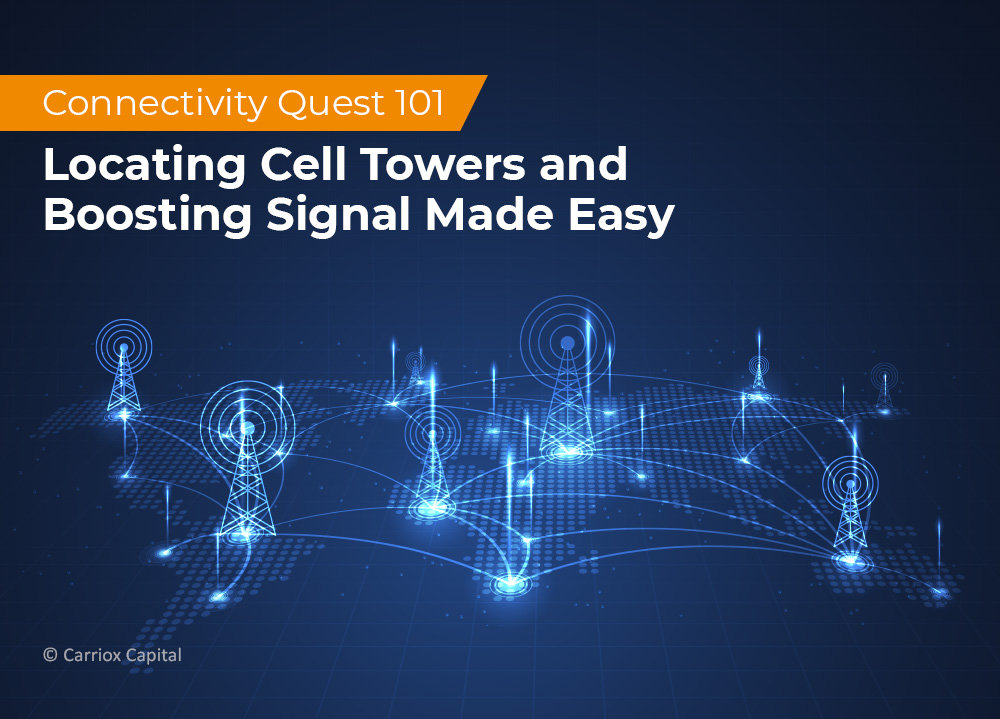The Comprehensive Guide to Finding Cell Towers and Maximizing Signal

The significance of robust and reliable cellular signals cannot be overstated in our interconnected world. The strength of cellular signals is pivotal in delivering crisp voice calls and lightning-fast data streams to our devices. Behind this seamless experience lies a highly specialized domain that oversees all aspects, from securing land and permits to cell tower construction, maintenance, and upgradation.
From 2022 to 2025, the cell tower industry will require over $600 billion in capex, with a predominant 85% allocated to advancing 5G networks. However, despite multi-billion-dollar cell tower infrastructural financing and careful planning, issues like dropped calls, sluggish internet speeds, and areas of patchy reception persist.
Here, finding and mapping cell towers become paramount to ensure seamless communication for every virtual interaction, from business transactions to entertainment consumption. Let’s explore practical techniques to navigate the nuances of tower tracking and signal enhancement.
5 Most Effective Techniques for Identifying and Mapping Nearby Cell Towers
Cell Tower Maps
Cell tower maps are indispensable tools for swiftly pinpointing nearby 4G LTE and 5G infrastructure. While major wireless carriers like Verizon, AT&T, and T-Mobile refrain from publicizing their official cell tower maps, a selection of autonomous providers like CellMapper fills the void with comprehensive cartographic resources.
These maps functioning on the principle of visual representation, facilitate the intuitive exploration of cell tower landscapes. Users can effortlessly discern the spatial distribution of cell towers by leveraging intuitive search criteria encompassing street names, cities, states, ZIP codes, and dynamic zooming.
Using Mobile Apps
Mobile applications offer tangible insights into nearby cell tower positioning and signal quality. Applications like Network Cell Info and OpenSignal are renowned for their precision and functionality. They adeptly identify the broadcasting bands of local cell towers and present a visual representation of cell locations on a Mozilla Location Service (MLS)-backed map. Users can access color-coded coverage maps denoting “good” and “poor” signal areas by selecting their respective operators, enhancing informed decision-making.
Cell Tower Company Websites
SBA Communications and Crown Castle are prominent websites offering user-friendly cell tower maps with intuitive navigation. These dynamic portals facilitate multifaceted searches encompassing address, coordinates, and site ID or name.
For instance, Crown Castle’s Infrastructure Solutions webpage offers a focused map for cell towers, excluding other digital infrastructure. The map interface supports precise address and place-based searches, augmented by seamless pan and zoom features that facilitate in-depth exploration of tower placements vital for professionals engaged in cell tower construction.
Wardriving
Wardriving emerges as a dynamic technique for uncovering the physical coordinates of nearby cellular towers while in transit. You’ll need a signal strength reader and a tower identifier like PCI or eNodeB ID. You can start driving toward the cell tower with the strongest signal until you spot it.
Wardriving helps determine the distance of the cell tower from your location and identifies any obstacles in the way. If multiple towers are nearby, this technique allows you to choose the best alignment of your signal booster antenna.
Utilizing Signal Strength Readings via Field Test Mode
You can determine the nearest cell tower’s location using your phone’s built-in signal strength reading through “Field Test Mode” on iOS and Android. This measurement is in decibel-milliwatts (dBm), indicating the radio wave strength. Signal strength ranges from -50 dBm (strong) to -120 dBm (very weak); below -125 dBm, you have no signal.
Uncovering cell tower locations through these techniques empowers better network utilization and introduces a unique investment opportunity. Don’t overlook the chance to invest in and profit from this vertical real estate through cell tower infrastructural financing, as the growing demand for enhanced coverage underlines their potential.
Next Steps to Enhance Signal Quality
Map Navigation: Filters for Providers and Coverage Areas
Esteemed platforms such as CellMapper and OpenSignal offer functionalities to pinpoint carrier-specific towers and their coverage areas. It also helps stakeholders involved in cell tower infrastructural financing with data on various aspects such as geographical attributes, building composition, proximity to towers, and network congestion. With this comprehensive awareness, strategic positioning of signal boosters becomes feasible.
Signal Strength Assessment
Each carrier interprets dBm differently regarding signal bars, and there’s no standard correlation between dBm and bars. However, dBm readings are consistent and precise, reflecting signal quality – closer to -50 dBm is better, while closer to -120 dBm is worse.
Signal Optimization Techniques
Several vital strategies can notably enhance signal quality:
Installation of Cell Phone Signal Boosters: These devices amplify feeble cell signals. Signal boosters, customized for various environments, such as residences, vehicles, and offices, empower users with fortified connectivity.
Switching to a Different Network: Some carriers excel in certain geographical regions, and altering your network allegiance could lead to a more robust signal reception.
Keeping Your Phone Up-to-Date: Ensuring your phone’s hardware and software are current is pivotal for sustaining optimal signal strength. Upgrading to a newer phone model with advanced antennas and support for modern network bands, including 5G, can yield amplified signal strength.
Telecom companies and subcontractors encounter cash flow constraints while maximizing signal quality network expansion, cell tower construction, and maintenance. Telecom invoice factoring emerges as a strategic solution, where telcos can gain swift access to funds by leveraging unpaid invoices.
Empowering Seamless Connectivity through Strategic Insights
The journey from identifying nearby cell towers to optimizing signal strength uncovers various dynamic techniques. As we explore cell tower maps, mobile apps, and signal strength assessments, we gain the power to enhance our connectivity experience. Amidst the ambitious growth of 5G networks and the substantial investments required for cell tower construction and expansion, the road ahead holds both challenges and opportunities. Whether navigating through precision filters, assessing signal strength nuances, or adopting optimization strategies, our ability to stay connected and profit from this evolving landscape is within reach.
Carriox’s tailored invoice factoring solutions for telecom operators, subcontractors, and cell tower constructors bridge the gap between payment cycles with cell tower infrastructural financing. Contact us today to streamline your journey toward enhanced connectivity and profitability.

Nitisha Jain
Nitisha Jain is the Content Manager at Panamax with over 12 years of experience in the industry. She is passionate about creating high-quality, informative, and engaging content for various audiences. In her current role, Nitisha is responsible for developing and executing content strategies for a variety of projects, including blog posts, articles, social media posts, website content, email campaigns, and more. She ensures that all the content published is on-brand and consistent with the company's overall messaging.

